Asus 2014 Annual Report Download - page 236
Download and view the complete annual report
Please find page 236 of the 2014 Asus annual report below. You can navigate through the pages in the report by either clicking on the pages listed below, or by using the keyword search tool below to find specific information within the annual report.-
 1
1 -
 2
2 -
 3
3 -
 4
4 -
 5
5 -
 6
6 -
 7
7 -
 8
8 -
 9
9 -
 10
10 -
 11
11 -
 12
12 -
 13
13 -
 14
14 -
 15
15 -
 16
16 -
 17
17 -
 18
18 -
 19
19 -
 20
20 -
 21
21 -
 22
22 -
 23
23 -
 24
24 -
 25
25 -
 26
26 -
 27
27 -
 28
28 -
 29
29 -
 30
30 -
 31
31 -
 32
32 -
 33
33 -
 34
34 -
 35
35 -
 36
36 -
 37
37 -
 38
38 -
 39
39 -
 40
40 -
 41
41 -
 42
42 -
 43
43 -
 44
44 -
 45
45 -
 46
46 -
 47
47 -
 48
48 -
 49
49 -
 50
50 -
 51
51 -
 52
52 -
 53
53 -
 54
54 -
 55
55 -
 56
56 -
 57
57 -
 58
58 -
 59
59 -
 60
60 -
 61
61 -
 62
62 -
 63
63 -
 64
64 -
 65
65 -
 66
66 -
 67
67 -
 68
68 -
 69
69 -
 70
70 -
 71
71 -
 72
72 -
 73
73 -
 74
74 -
 75
75 -
 76
76 -
 77
77 -
 78
78 -
 79
79 -
 80
80 -
 81
81 -
 82
82 -
 83
83 -
 84
84 -
 85
85 -
 86
86 -
 87
87 -
 88
88 -
 89
89 -
 90
90 -
 91
91 -
 92
92 -
 93
93 -
 94
94 -
 95
95 -
 96
96 -
 97
97 -
 98
98 -
 99
99 -
 100
100 -
 101
101 -
 102
102 -
 103
103 -
 104
104 -
 105
105 -
 106
106 -
 107
107 -
 108
108 -
 109
109 -
 110
110 -
 111
111 -
 112
112 -
 113
113 -
 114
114 -
 115
115 -
 116
116 -
 117
117 -
 118
118 -
 119
119 -
 120
120 -
 121
121 -
 122
122 -
 123
123 -
 124
124 -
 125
125 -
 126
126 -
 127
127 -
 128
128 -
 129
129 -
 130
130 -
 131
131 -
 132
132 -
 133
133 -
 134
134 -
 135
135 -
 136
136 -
 137
137 -
 138
138 -
 139
139 -
 140
140 -
 141
141 -
 142
142 -
 143
143 -
 144
144 -
 145
145 -
 146
146 -
 147
147 -
 148
148 -
 149
149 -
 150
150 -
 151
151 -
 152
152 -
 153
153 -
 154
154 -
 155
155 -
 156
156 -
 157
157 -
 158
158 -
 159
159 -
 160
160 -
 161
161 -
 162
162 -
 163
163 -
 164
164 -
 165
165 -
 166
166 -
 167
167 -
 168
168 -
 169
169 -
 170
170 -
 171
171 -
 172
172 -
 173
173 -
 174
174 -
 175
175 -
 176
176 -
 177
177 -
 178
178 -
 179
179 -
 180
180 -
 181
181 -
 182
182 -
 183
183 -
 184
184 -
 185
185 -
 186
186 -
 187
187 -
 188
188 -
 189
189 -
 190
190 -
 191
191 -
 192
192 -
 193
193 -
 194
194 -
 195
195 -
 196
196 -
 197
197 -
 198
198 -
 199
199 -
 200
200 -
 201
201 -
 202
202 -
 203
203 -
 204
204 -
 205
205 -
 206
206 -
 207
207 -
 208
208 -
 209
209 -
 210
210 -
 211
211 -
 212
212 -
 213
213 -
 214
214 -
 215
215 -
 216
216 -
 217
217 -
 218
218 -
 219
219 -
 220
220 -
 221
221 -
 222
222 -
 223
223 -
 224
224 -
 225
225 -
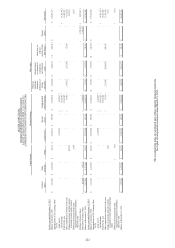 226
226 -
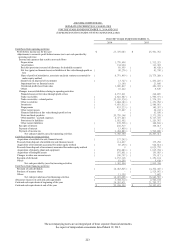 227
227 -
 228
228 -
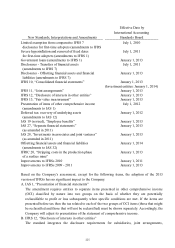 229
229 -
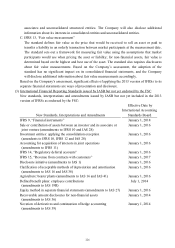 230
230 -
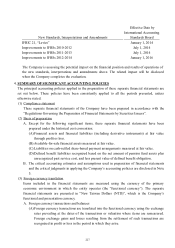 231
231 -
 232
232 -
 233
233 -
 234
234 -
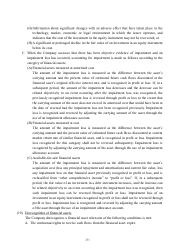 235
235 -
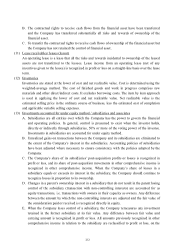 236
236 -
 237
237 -
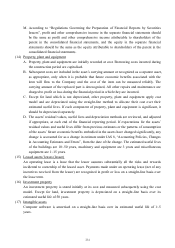 238
238 -
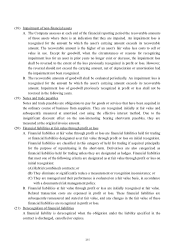 239
239 -
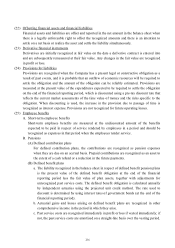 240
240 -
 241
241 -
 242
242 -
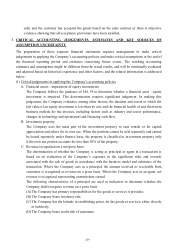 243
243 -
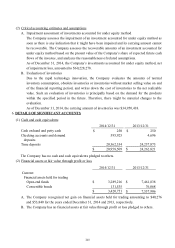 244
244 -
 245
245 -
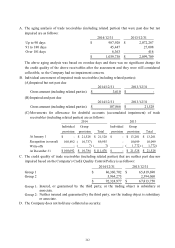 246
246 -
 247
247 -
 248
248 -
 249
249 -
 250
250 -
 251
251 -
 252
252 -
 253
253 -
 254
254 -
 255
255 -
 256
256 -
 257
257 -
 258
258 -
 259
259 -
 260
260 -
 261
261 -
 262
262 -
 263
263 -
 264
264 -
 265
265 -
 266
266 -
 267
267 -
 268
268
 |
 |

232
B. The contractual rights to receive cash flows from the financial asset have been transferred
and the Company has transferred substantially all risks and rewards of ownership of the
financial asset.
C. To transfer the contractual rights to receive cash flows of ownership of the financial asset but
the Company has not retained the control of financial asset.
(11) Lease receivables/ leases (lessor)
An operating lease is a lease that all the risks and rewards incidental to ownership of the leased
assets are not transferred to the lessees. Lease income from an operating lease (net of any
incentives given to the lessee) is recognized in profit or loss on a straight-line basis over the lease
term.
(12) Inventories
Inventories are stated at the lower of cost and net realizable value. Cost is determined using the
weighted-average method. The cost of finished goods and work in progress comprises raw
materials and other direct/indirect costs. It excludes borrowing costs. The item by item approach
is used in applying the lower of cost and net realizable value. Net realizable value is the
estimated selling price in the ordinary course of business, less the estimated cost of completion
and applicable variable selling expenses.
(13) Investments accounted for under equity method / subsidiaries and associates
A. Subsidiaries are all entities over which the Company has the power to govern the financial
and operating policies. In general, control is presumed to exist when the investor holds,
directly or indirectly through subsidiaries, 50% or more of the voting power of the investee.
Investments in subsidiaries are accounted for under equity method.
B. Unrealized gains on transactions between the Company and its subsidiaries are eliminated to
the extent of the Company’s interest in the subsidiaries. Accounting policies of subsidiaries
have been adjusted where necessary to ensure consistency with the policies adopted by the
Company.
C. The Company’s share of its subsidiaries’ post-acquisition profits or losses is recognized in
profit or loss, and its share of post-acqusition movements in other comprehensive income is
recognized in other comprehensive income. When the Company’s share of losses in a
subsidiary equals or exceeds its interest in the subsidiary, the Company should continue to
recognize losses in proportion to its ownership.
D. Changes in a parent’s ownership interest in a subsidiary that do not result in the parent losing
control of the subsidiary (transaction with non-controlling interests) are accounted for as
equity transactions, i.e. transactions with owners in their capacity as owners. Any difference
between the amount by which the non-controlling interests are adjusted and the fair value of
the consideration paid or received is recognized directly in equity.
E. When the Company loses control of a subsidiary, the Company remeasures any investment
retained in the former subsidiary at its fair value. Any difference between fair value and
carrying amount is recognized in profit or loss. All amounts previously recognized in other
comprehensive income in relation to the subsidiary are reclassified to profit or loss, on the
